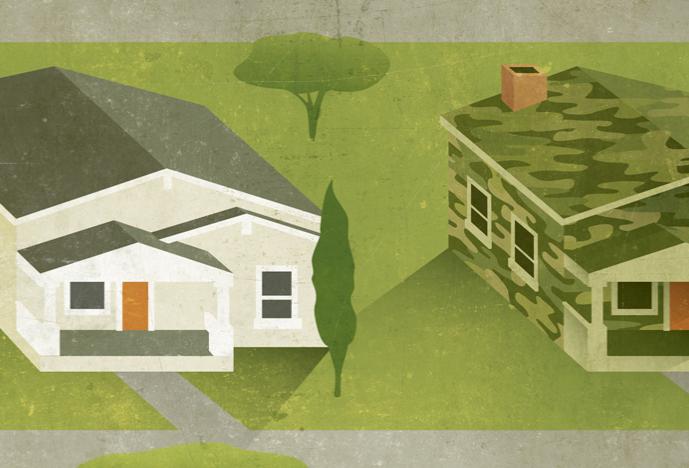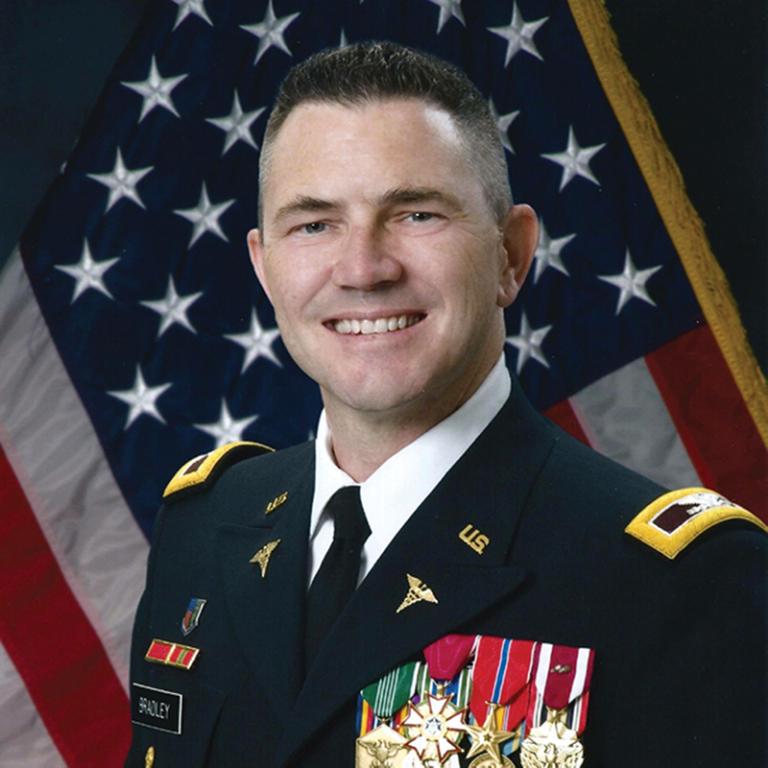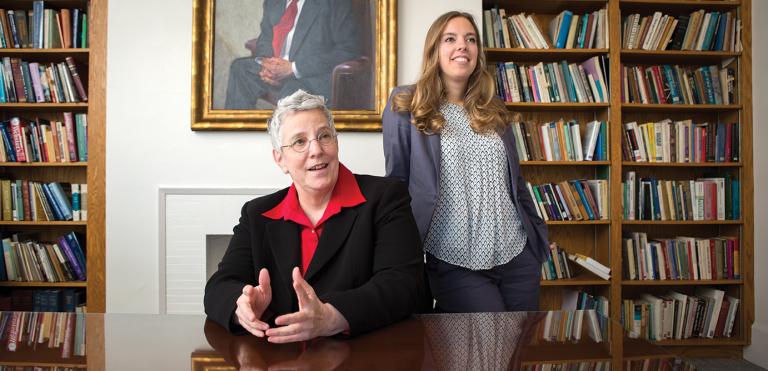Here, Yet Not Here
When traumatic events etch themselves in the brain, behavior, well-being, and even the perception of reality can become altered, disrupting daily life
- Feature

Throughout most of his life, John Bradley has, in one form or another, lived with post-traumatic stress disorder. As a youth, he witnessed his father, a career officer and two-tour veteran of the Vietnam War, struggle with it. And, as a physician who served multiple deployments, including a tour in Iraq, Bradley experienced it himself.
“For months after returning from Iraq, I would hear small-arms fire as I fell asleep each night,” says Bradley, an HMS associate professor of psychiatry and a retired U.S. Army colonel. “I experienced hyperarousal symptoms and anxiety. I’ve absolutely been affected by PTSD.”

Bradley credits his psychiatry training for helping him recognize his symptoms and manage them effectively using the same approaches he uses for his patients. But he was also aided by the example of his father.
“I chose psychiatry as a specialty and the military as a career because of my family. I saw the profound effect that combat experience had on my dad and the burden that he carried and continues to carry with him,” Bradley says. “Nevertheless, his life has had a great deal of effectiveness and joy.”
Despite never receiving treatment for PTSD and exhibiting symptoms even into his eighties, Bradley says his father lived a full, healthy life by being able to reconcile his combat experiences with his civilian life. This personal observation has been important for Bradley, who, in his role as chief of psychiatry and deputy director for the mental health service at the VA Boston Healthcare System, oversees psychiatric practice and professional development for hundreds of mental health clinicians and staff.
“The question I think we should be trying to help those with PTSD answer is: ‘Can you regain effectiveness in your life, whether that’s with your family or with your job, even when the symptoms occur?’” Bradley says. “Yes, you want to control symptoms so that people can function, but the more important therapeutic issue is really an existential one: ‘Can you develop a narrative you can live with?’”
Researchers at HMS and elsewhere are working to develop an understanding of PTSD’s many facets in the hope of improving diagnosis of the disorder and developing treatments that can help and heal. But the task is daunting: The disorder is rooted in biology and medicine, weighted with cultural constructs that shape self-perception and expectation, and, according to a growing number of experts, deepened by one’s personal moral code.
The War at Home
Since 2001, nearly three million U.S. servicemembers have been deployed to Afghanistan and Iraq. During their time overseas, most of these soldiers witness or live through life-threatening traumatic events. When they return home, as many as 20 percent develop PTSD.
The symptoms of PTSD can be disabling: persistent nightmares, flashbacks, avoidance of reminders of a traumatic event—including one’s own thoughts and feelings—negative worldview, and increased physiological tension or hyperarousal. PTSD trails only tinnitus and hearing loss as the most common disability for which veterans receive compensation from the VA. In more than half of the people diagnosed with the disorder, PTSD co-occurs with depression, substance abuse, traumatic brain injury, or other psychological and physiological manifestations. This constellation of burdens can turn the activities of daily life into insurmountable obstacles.
The social and economic costs are enormous. According to a 2008 RAND Corporation analysis, “PTSD and depression among returning service members will cost the nation as much as $6.2 billion in the two years following deployment—an amount that includes both direct medical care and costs for lost productivity and suicide.”

Age-Old Suffering
For as long as humans have experienced war, conflict, and trauma, they have suffered from PTSD. It’s just often been called something else.
In the Epic of Gilgamesh, a work of literature dating back some 4,000 years, a Sumerian king, Gilgamesh, suffered nightmares and wandered numb through his kingdom after witnessing the death of his friend Enkidu. Another ancient example can be found in the Ramayana, an epic Indian poem from the fifth millennium BCE. The poem details the terror-filled recollections of the demon Marrich after he was almost killed by the hero Rama—Marrich goes so far as to avoid the mention of things that start with the letter R.
In the 1600s, doctors in Europe noted that Swiss mercenaries were increasingly gripped by despair, sleeplessness, and severe homesickness, a condition they dubbed nostalgia. During the U.S. Civil War, physicians found that nostalgia was often accompanied by mania, withdrawal, or destructive behaviors. Veterans exhibiting these symptoms filled post-war asylums.
During World War I, soldiers afflicted with nightmares, tremors, and psychological and physical disorientation were said to be suffering from shell shock, while World War II saw this array of symptoms come to be known as battle fatigue or combat stress reaction. The symptoms were chalked up to exhaustion from long deployments.
A new discourse about such symptoms, however, started percolating during the Vietnam War. Sparked by the 1972 New York Timesop-ed column, “Post-Vietnam Syndrome,” by Canadian psychiatrist Chaim Shatan, the medical community began to investigate in earnest the psychological consequences of combat stress.
By the Book
Psychiatrists formally acknowledged PTSD as a medical disorder in 1980, including criteria for its diagnosis in the third edition of the American Psychiatric Association’s Diagnostic and Statistical Manual of Mental Disorders (DSM-III).
The primary diagnostic criterion was based on whether an individual had been exposed to an overwhelming stressor, one on the edges of normal human experience, such as war, sexual assault, and catastrophic disasters, natural or otherwise. This perspective was a dramatic shift in thinking; the disorder went from being a condition resulting from personal weakness to one initiated by external forces that swamped a person’s ability to cope.
The National Comorbidity Survey Replication, conducted between February 2001 and April 2003, estimated that nearly 7 percent of adults in this country would, at some point in their lifetime, develop PTSD as a result of exposure to traumatizing situations such as domestic abuse and serious accident or injury. Yet the nature of war—the repeated, unavoidable exposures to death, horror, and trauma—binds the disorder to the experience of soldiers. Addressing the causes of and treatment for PTSD, therefore, is a central part of the mission of the Veterans Health Administration, the federal health care system responsible for the medical needs of an estimated 20 million veterans, many of whom struggle with PTSD for much of their lives.
“I still encounter World War II veterans who, as you engage them in conversation during a visit, will start to cry and talk about things that happened more than seventy years ago,” says Michael Charness, an HMS professor of neurology and chief of staff of the VA Boston Healthcare System.
A Window Within
According to Charness, there has been a growing acceptance that PTSD is a bona fide disorder that affects the structure and function of the brain. Some of the earliest and strongest evidence for its biological basis arose from studies conducted by VA scientists in the late 1980s, including those led by Roger Pitman, now an HMS professor of psychiatry and director of the PTSD research laboratory at Massachusetts General Hospital, and his colleagues.
Adapting an experimental paradigm known as script-driven imagery, Pitman and colleagues asked combat veterans to describe their traumatic experiences and detail how they felt during those experiences. The researchers then composed short personalized scripts based on the descriptions and measured participants’ biological responses as the scripts were read aloud back to them. Participants were instructed to remember the moment as vividly as possible.
In one set of experiments, published in the Archives of General Psychiatryin 1996, Pitman’s team used this approach while scanning the brains of PTSD patients. Those scans found that the brain regions involved in responding to threats—those areas involved in the fight or flight response—were hyperactive, particularly the amygdala, which plays a primary role in emotion and fear, and the dorsal anterior cingulate cortex, which connects the amygdala with a cortical region responsible for inhibiting cognition and executive function. At the same time, the region of the brain that plays a role in inhibiting emotional responses appeared to be underactive.
In other studies, says Lauren Lebois, an HMS instructor in psychiatry in the Neurobiology of Fear Laboratory at McLean Hospital, brain scans of people diagnosed with PTSD have shown the opposite response.
“What we’ve seen from functional neuroimaging studies is that brain activity in individuals with PTSD can go awry in two different directions,” says Lebois. “In some individuals, the parts of their brains responsible for the stress response become overactive and the parts that act as braking mechanisms to the stress response are underactive compared to individuals without PTSD. In a subset of other individuals with PTSD, threatening stimuli trigger the opposite sort of brain pattern—parts of their brains responsible for stress response become underactive and parts that act as braking mechanisms to stress response become overactive.”
As technologies advance so do efforts by researchers to identify the molecular and genetic factors associated with PTSD. As with other psychiatric disorders, PTSD likely involves the interaction of various genes that contribute to its development and progression, a fact that underscores the need for initiatives such as the VA’s Million Veteran Program. As of September 2017, this program had collected blood and DNA samples as well as electronic medical records and longitudinal health and lifestyle surveys from more than 600,000 veterans, making it the world’s largest genomic database tied to a health care system.
With the goal of collecting all one million samples by 2020, program researchers aim to provide scientists with the data and statistical power needed to better understand, diagnose, and treat complex diseases. Studies on PTSD and substance abuse are already underway.
Soul-Wrenching
War breeds experiences that, under normal circumstances, would be unthinkable for most people: harming or killing civilians; following illegal or immoral orders; witnessing atrocities committed on noncombatants or fellow soldiers; failing to intervene or report such acts. Any of these experiences can challenge a soldier’s core moral and ethical beliefs.
Bradley still relives one such moment. He was commanding a four-vehicle convoy moving through the streets of Najaf, Iraq, when the Humvees crossed paths with a procession celebrating the festival of Eid al-Fitr, the end of the month of Ramadan. The soldiers’ presence at the holy celebration infuriated the crowd. Soon, the Humvees were being rocked in an attempt to flip them. Bradley and his team freed themselves the only way they could.
“We drove back and forth to push the assailants away,” says Bradley. “We were able to extricate ourselves, but we wounded a number in the crowd.”
According to Alex Jordan, a staff psychologist at McLean Hospital who has served as the PTSD expert evaluator for the VA and Department of Defense jointly funded Consortium to Alleviate PTSD, military servicemembers “are trained to deal with threats to their life but not as much for dealing with the other realities of combat.”
“Many are haunted most by events that didn’t cause them to feel terror, but rather shame, guilt, anger, or resentment,” he adds. “This violation of moral expectations that one holds for oneself or other people may cause what we call moral injury.” Jordan has co-authored several publications on moral injury, including, in 2017, a clinical primer on the spiritual features of war-related moral injury in the journal Spirituality in Clinical Practice.
“It was clear to me many years ago that our paradigm for PTSD was not sufficient,” says Brett Litz, a professor in the Department of Psychiatry at the Boston University School of Medicine and a psychologist at the VA Boston Healthcare System, who has spent the better part of the past two decades studying unusual aspects of military-related psychic damage.
“There is an expectation that all traumas are alike in the diagnostic manual, but war trauma has a completely different sociocultural context from most others.”
“There is an expectation that all traumas are alike in the diagnostic manual,” he adds, “but war trauma has a completely different sociocultural context from most others.” In 2009, Litz authored a review that presented a preliminary model and intervention strategy for moral injury. He has since published several studies on the topic, including one describing the first potential treatment specifically for moral injury, an exposure-based intervention called adaptive disclosure.
“The stakes are higher for war. The loss of life, the grotesque nature of armed conflict, these affect the humanity of people who feel they’re engaging in something honorable,” Litz adds. “This incongruity can leave a lasting harmful effect.”

The Core of the Matter
In an effort to develop insights for possible new treatments for PTSD, Milissa Kaufman, an HMS instructor in psychiatry, and, at McLean Hospital, medical director of the Hill Center for Women and director of the Dissociative Disorders and Trauma Research Program, has been using imaging and genetic and neurocognitive testing to determine how different conditions contribute to and interact with PTSD. Her studies focus on women who have been diagnosed with PTSD and have multiple co-occurring medical and psychiatric issues.
“PTSD is very complicated, and there are many factors that have to be considered at the same time,” says Kaufman. “But PTSD is PTSD. Patients will have intrusive memories, physiological responses to triggers, avoidance behaviors, and negative perspectives on themselves and the world around them. There are well-validated, empirically based treatments that can help them.”
Clinical trials have shown that approaches such as cognitive processing therapy, which teaches patients to evaluate and change their thoughts about their trauma, and prolonged exposure therapy, which helps patients overcome avoidance by confronting their memories and feelings, effectively reduce the severity of PTSD symptoms. Reviews of these therapeutic approaches have shown that, depending on the study parameters, one-half to two-thirds of those who complete treatment demonstrate clinically meaningful improvement or no longer meet the diagnostic criteria for PTSD.
While psychotherapy is the clear front-line treatment for PTSD, augmenting that therapy with medications such as antidepressants, which block the reuptake of certain neurotransmitters, have been shown to help modulate mood and anxiety in some cases. Many other pharmaceuticals have been evaluated or are undergoing evaluation for PTSD, including antipsychotics, mood stabilizers, and antianxiety medications. More recently, the use of synthetic dissociative drugs such as ketamine and psychoactive agents such as MDMA have been explored. Evidence of efficacy, however, remains scant for the majority of these drugs.
Ensuring that those affected with PTSD seek and adhere to treatments is not an easy task. Social stigma can cause patients to shun help and dismiss treatment. Recent surveys by the National Academy of Sciences have found that about 50 percent of the veterans who need mental health help, particularly those without close family and friends, do not seek treatment.
In an effort to increase the number of veterans who do seek help, the VA and its partners have launched initiatives that deliver treatments virtually, allowing access through personal computers and handheld devices. Complementary medicine approaches, from yoga and meditation to acupuncture and the use of virtual reality technology, also are being explored. There is some evidence that, when combined with standard treatments, these approaches can have a beneficial effect.
Even as research into the causes, symptoms, epidemiology, and treatment for PTSD continues, the condition that has accompanied human conflict for millennia still shows itself through its effects on individuals, families, and communities. Conflict may always be with us, but the drive to find ways to decipher, prevent, and alleviate the trauma it engenders will always be there as well.
Kevin Jiang is a science writer in the HMS Office of Communications and External Relations.
Images: Traci Daberko (top); courtesy of John Bradley; RGlinsky/Essentials/Getty; John Soares (Kaufman, Lebois)